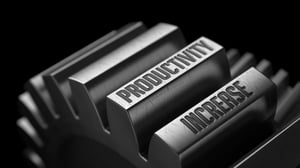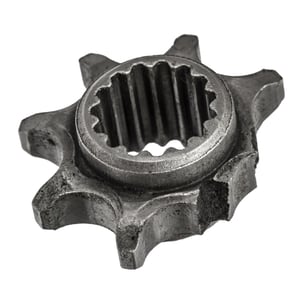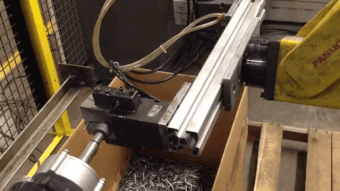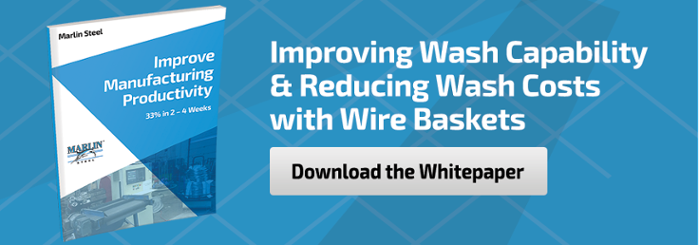 For manufacturers, throughput in production can mean the difference between meeting quotas and losing customers to the competition. Falling behind on manufacturing throughput means delayed deliveries, which can cause customers to find other, more timely suppliers.
For manufacturers, throughput in production can mean the difference between meeting quotas and losing customers to the competition. Falling behind on manufacturing throughput means delayed deliveries, which can cause customers to find other, more timely suppliers.
Finding effective ways to increase throughput helps manufacturers meet their quotas and satisfy their customer.
Before delving into tips for improving throughput, it’s important to note that there’s a difference between throughput and output. Basically, output is your total production, including scrap, rejections, and stockpiled products, while throughput only counts the parts that are successfully delivered and accepted by the customer.
With this in mind, how can manufacturers reliably increase their throughput?
Eliminate Throughput Bottlenecks
One of the most effective ways to improve throughput in manufacturing is to carefully analyze your production process for bottlenecks. Once identified, you can work to eliminate the bottleneck so that it no longer delays production.
Some solutions may be to add extra stations to a long process so more parts can be processed at once, or to find ways to make the process more efficient, or possibly even eliminate the process entirely and replace it with a different one. The solution depends on factors such as spare floor space, expense of equipment involved, and the nature/necessity of the process.
Check out some more advice for improving productivity here!
Reduce the Parts Rejection Rate
 Raw manufacturing capacity is important. However, it’s possible to have a high output, but still fail to meet throughput goals because of parts rejections.
Raw manufacturing capacity is important. However, it’s possible to have a high output, but still fail to meet throughput goals because of parts rejections.
If a manufacturer can produce 1,000 parts per hour, but has a 10% rejection rate, they’ll waste 100 parts every hour, or 800 parts a shift. Were this manufacturer to cut their rejection rate by half, throughput would increase by 400 parts per shift. This would make it far easier to meet quotas, and reduce money wasted on remanufacturing or reprocessing parts.
Look for elements in your production process that can damage your parts or cause them to fail to meet production tolerances. By identifying and remediating these issues, you can improve production throughput and increase customer satisfaction with your products.
Improve Employee Training
The frontline workers manning the production line have a huge impact on manufacturing cycle efficiency and product quality.
When employees lack the necessary training, they may struggle to find improvements that they can make. Worse yet, undertrained employees may accidentally create delays because they don’t understand the entirety of the production process and how a tweak that saves them a minute creates 5 minutes of extra work for someone else.
Focusing on employee training so they have the skills to make positive, well-informed changes to the production process is key to maximizing throughput.
Use Factory Automation
 When you have to meet tight production tolerances measured in millimeters, manual labor simply doesn’t cut it. Even the best workers get tired and sore after a few hours of heavy labor, which leads to reduced consistency of work and increased risk of injury.
When you have to meet tight production tolerances measured in millimeters, manual labor simply doesn’t cut it. Even the best workers get tired and sore after a few hours of heavy labor, which leads to reduced consistency of work and increased risk of injury.
By using production automation, manufacturers can massively increase throughput and improve the quality of life for their workers. At Marlin, the workers who would once have to do backbreaking heavy labor to bend thick steel wire can focus on planning, programming, and other cerebral tasks while the machines do the dangerous work.
Unlike a human worker, manufacturing machines don’t get tired from physical exertion. Each and every operation is carried out with the same machine-like precision for hours on end. This helps ensure that every part produced will meet the same production tolerances.
In many cases, simply having the right tool for the job can have a massive impact on productivity.
Learn how automation is changing the face of manufacturing!
Minimize Physical Prototyping Where Possible
Creating a physical prototype of a part or product is a slow, expensive process. If the prototype doesn’t meet the needs of the customer, then all of the tooling and time spent on that prototype will go to waste.
Marlin Steel countered this issue by using physics simulation software to run virtual tests of product designs before committing to tooling for a physical product. These virtual tests can be carried out in mere minutes, and any issues that would cause the product to fail are noted in the simulator for Marlin’s degreed engineers to fix.
This helps to ensure that the production run is the only run.
When a physical prototype is necessary, Marlin can produce many items that would normally need special tooling by using a 3D printer instead. While less efficient than traditional production for large product runs, the 3D printer is ideal for a limited, one-time production because it eliminates the need for tooling.
Learn about how Marlin stress tests basket designs without physical prototypes!
Increase Manufacturing Safety
One of the biggest impairments to manufacturing throughput is lost-time safety incidents. When a worker gets injured on the production floor, manufacturing work gets ground to a halt almost immediately.
Yet, the temporary delay of dropping everything to take care of the injured employee is the least of a manufacturer’s worries.
A single safety incident can have protracted consequences, including:
- The loss of a skilled, efficient worker
- Floor closures for investigations into the incident
- Workman’s comp claims
- Increased insurance costs
- Damage to the production equipment
The list goes on and on. By making the factory floor safer for employees, you can avoid these costly, production-lowering issues and keep your factory floor running smoothly and efficiently.
Learn more about how to increase production capacity in manufacturing from Marlin Steel today!




.gif)


